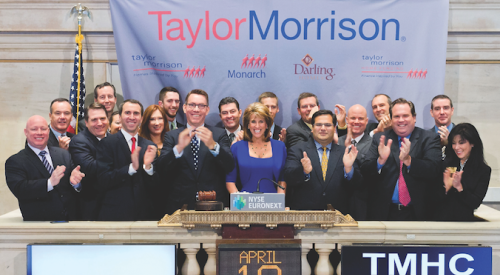|
||||||||||||||||||||||||||||||||||||||||||||||||||||
Maybe public home builders will finally get their due. The big builders have always felt under appreciated by investors and analysts, but for more than a year, it’s really been acute. Single-digit price/ earnings ratios reflect the investment community’s disenchantment, despite the builders’ stellar profit and growth performance. But now, Forbes magazine’s recent "Platinum 400" ranking of the best performing big public companies in America contains the names of nine publicly-traded residential builders.
The respected business monthly chose its Platinum 400 from among 1280 giant public companies in 20 industries, ranking them on the basis of five years worth of stock price changes and a complex formula measuring profitability and growth. To make the list, Forbes reports a company "must be an industry leader in long-term and short-term return on capital, growth in both sales and earnings and in still other financial metrics..." Among others IBM and Hewlett-Packard fell short of the mark.
NVR is the top-ranked builder on the list, at No.11, with an 833% stock price appreciation over five years. Next up is MDC at No.76, Standard Pacific at 92, Pulte at 154, KB Home at 175, D.R. Horton at 193, Toll Brothers at 230, Lennar at 259, and Del Webb No. 307.
The broad implications of the housing industry’s strong presence in the Forbes ranking may be more important, over time, than any new respect the listed builders gain from stock analysts or investors. "When nine builders make a list that IBM and Hewlett-Packard can’t crack, it shows this is a good business, and that we’re on a real run," says David Weekley, chairman of the Houston-based private Giant.
Toll Brothers chairman Robert Toll says the builders’ performance in the Forbes Platinum 400 shows that housing has come of age. "This is no longer an industry of gun-toting, risk-taking entrepreneurs," he says. "All of the companies on that list are well-managed. They show good returns. But perhaps more important, they show consistent returns.
"With declining volatility, we’ve been able to build stability into our operations. Ten years ago, nobody was talking about even-flow production." Toll plans to use the Platinum 400 to help meet the biggest need on his agenda - people - especially management talent. "I think this is something we can use as a recruiting tool on campuses," he says. "It shows this is a business with a career path. If a bright young person comes into this industry with a lot of ambition, he or she can go a long, long way."
The $64 million question is whether, in the short or long term, it will have any effect on Wall Street’s perception of housing stocks as purely cyclical plays, unworthy of being held for long periods. "Probably not," says analyst John Stanley of UBS Warburg. "If you look at the big picture for public home builders, you see that the extremes of business and construction cycles are gone. Interest rates are low and stable. Economic growth and demand remain strong, and land is in short supply - which actually works in favor of the big public builders and against small private ones.
"There’s a whole lot about the world that looks really good for big builders, and the Forbes 400 reflects that," says Stanley. "But to investors, this is still a cyclical sector, only suitable for short-term plays, which means they look for the bottom of the cycle as the time to buy. The trouble is, the cycle is hard to see. For the last several years, they’ve been waiting for it to show up. It’s the ‘other shoe’ syndrome. But just look at the growth and returns on investment of these companies..."
Forbes has seen the light, and the steady improvement in share prices for the builders over the last six months shows that at least some of the flight from overpriced high-tech stocks is landing in the housing sector. For instance, NVR traded early this month at $152.93, high in a 52-week range of $43.1875 to $154.67. MDC was at $35.20 in a 52-week range of $12.4432 to $41.45. And Toll was trading at $37.75 a share, on a range of $15.8125 to $45.25.
"In terms of performance, we’re all strong," says D.R. Horton chairman Don Horton. "But why do investors still relate builders to a cycle that no longer exists? We’re trading at a multiple of seven. If we were trading at the normal P/E for our nine-year history as a public company - 11 - our stock would trade at $35 a share instead of $23. Somebody out there should see a 52% upside in our stock, especially since we’ve been growing at a compounded annual rate of 40%."
Toll draws a similar conclusion: "Last spring, you guys ran ‘Out of Whack on Wall Street’ and it was very perceptive," he says. "Do you know that if people had taken that to heart, they could have made about 75% on their moneys?"
If the light ever goes on above investors’ heads and builder stocks begin to trade at double-digit multiples again, it could touch off another round of consolidation in the housing industry. Big public builders are rolling in cash. Improved multiples would turn their shares into the currency they need to grow by acquisition.
The Lennar/U.S. Home deal remains a benchmark for others with lofty aspirations. Last spring, we predicted that first mega-merger might not be the last. Dismal share prices put any bigger deals on the back burner. But now they may be beginning to sizzle.
Also See
Out of Whack on Wall Street












